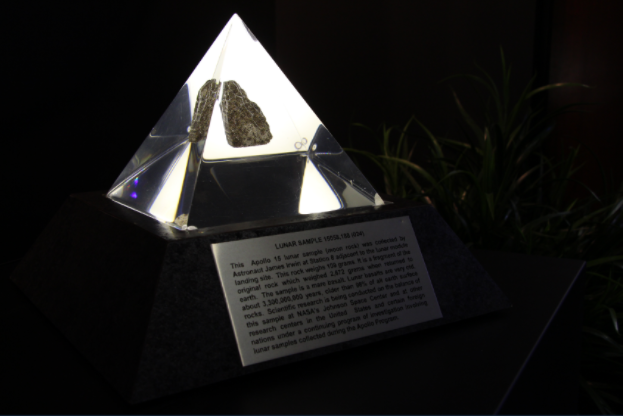In what proved to be the biggest event for the Dice Mineralogical Museum since its dedication in 2012, the public reception for the Apollo 15 lunar sample on loan from NASA was a tremendous success. Over 200 visitors from around West Michigan stopped by the evening of Monday night, November 28, to witness the unveiling of the museum’s new exhibit, and the display even caught the attention of the local news stations Wood TV 8 and WZZM 13. Professor Renee Sparks of the geology department organized the acquisition of the sample and expressed her excitement for the success of the reception.
“The night was fantastic,” said Sparks. “With big-band music playing in the background, and the sample illuminated, students and faculty members came together to see a piece of history contained in a rock.” In addition to the new display, an interactive exhibit was set up in an adjacent room to show visitors what earthly rocks of similar composition look and feel like, while a documentary on the Apollo 15 mission played in the background.
The Chair of the Geology, Geography and Environmental Studies department, Jason VanHorn, understands the significance of the new display. “For Calvin College to have the lunar sample is a wonderful opportunity to deepen our connection with the community of Grand Rapids and the region.”
We have the advantage of sharing with everyone who has interests in earth sciences like geology or physical geography.” He also extends deep appreciation to the generous donation from Bruce Dice, whose gift of a highly secure museum allows us to host such a priceless natural artifact.
Junior geology major and museum docent Maia Madrid happily shared the moon rock with our community Monday night. “Aside from simply being incredibly cool, the presence of a lunar rock at Calvin gives students and community members an opportunity to learn not only about the moon, which is clearly an integral part of life here on earth, but also to think about geology and creation in an extra-terrestrial context.”
This rock represents something far greater than a simple assemblage of minerals. Professor VanHorn elaborates: “The moon rock reminds me that nothing is impossible with God, and my hope is that the lunar sample will bring inspiration to current and future generations of earth scientists, explorers, and adventurers, and that even that which seems to be impossible can be overcome. We are thrilled to have such a precious resource here at the museum.”
The moon rock will be on display from now until February 15 in the Dice Mineral Museum located on the first floor of North Hall, which will be open next week Wednesday, Thursday and Friday from 12:30 – 4:00 pm, or by appointment. We hope you stop by to take a look at this piece of history.








